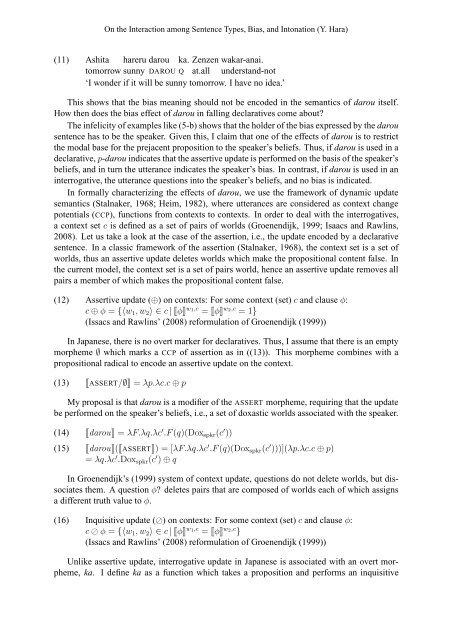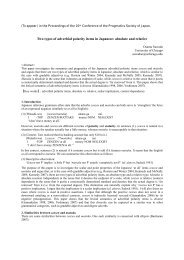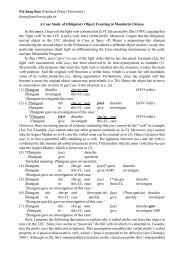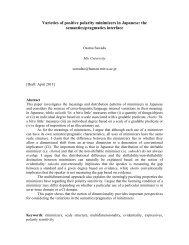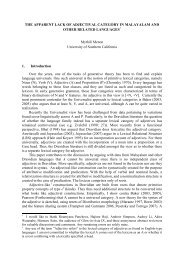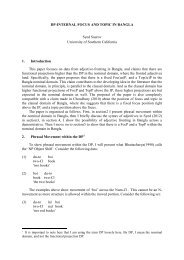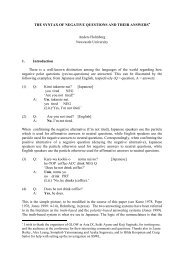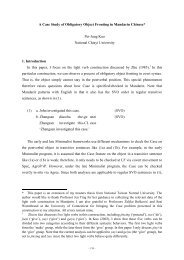On the Interaction Among Sentence Types, Bias, and Intonation
On the Interaction Among Sentence Types, Bias, and Intonation
On the Interaction Among Sentence Types, Bias, and Intonation
Create successful ePaper yourself
Turn your PDF publications into a flip-book with our unique Google optimized e-Paper software.
<strong>On</strong> <strong>the</strong> <strong>Interaction</strong> among <strong>Sentence</strong> <strong>Types</strong>, <strong>Bias</strong>, <strong>and</strong> <strong>Intonation</strong> (Y. Hara)<br />
(11) Ashita hareru darou ka. Zenzen wakar-anai.<br />
tomorrow sunny DAROU Q at.all underst<strong>and</strong>-not<br />
‘I wonder if it will be sunny tomorrow. I have no idea.’<br />
This shows that <strong>the</strong> bias meaning should not be encoded in <strong>the</strong> semantics of darou itself.<br />
How <strong>the</strong>n does <strong>the</strong> bias effect of darou in falling declaratives come about<br />
The infelicity of examples like (5-b) shows that <strong>the</strong> holder of <strong>the</strong> bias expressed by <strong>the</strong> darou<br />
sentence has to be <strong>the</strong> speaker. Given this, I claim that one of <strong>the</strong> effects of darou is to restrict<br />
<strong>the</strong> modal base for <strong>the</strong> prejacent proposition to <strong>the</strong> speaker’s beliefs. Thus, if darou is used in a<br />
declarative,p-darou indicates that <strong>the</strong> assertive update is performed on <strong>the</strong> basis of <strong>the</strong> speaker’s<br />
beliefs, <strong>and</strong> in turn <strong>the</strong> utterance indicates <strong>the</strong> speaker’s bias. In contrast, if darou is used in an<br />
interrogative, <strong>the</strong> utterance questions into <strong>the</strong> speaker’s beliefs, <strong>and</strong> no bias is indicated.<br />
In formally characterizing <strong>the</strong> effects of darou, we use <strong>the</strong> framework of dynamic update<br />
semantics (Stalnaker, 1968; Heim, 1982), where utterances are considered as context change<br />
potentials (CCP), functions from contexts to contexts. In order to deal with <strong>the</strong> interrogatives,<br />
a context set c is defined as a set of pairs of worlds (Groenendijk, 1999; Isaacs <strong>and</strong> Rawlins,<br />
2008). Let us take a look at <strong>the</strong> case of <strong>the</strong> assertion, i.e., <strong>the</strong> update encoded by a declarative<br />
sentence. In a classic framework of <strong>the</strong> assertion (Stalnaker, 1968), <strong>the</strong> context set is a set of<br />
worlds, thus an assertive update deletes worlds which make <strong>the</strong> propositional content false. In<br />
<strong>the</strong> current model, <strong>the</strong> context set is a set of pairs world, hence an assertive update removes all<br />
pairs a member of which makes <strong>the</strong> propositional content false.<br />
(12) Assertive update (⊕) on contexts: For some context (set)c<strong>and</strong> clauseφ:<br />
c⊕φ = {〈w 1 ,w 2 〉 ∈ c|φ w 1,c = φ w 2,c = 1}<br />
(Issacs <strong>and</strong> Rawlins’ (2008) reformulation of Groenendijk (1999))<br />
In Japanese, <strong>the</strong>re is no overt marker for declaratives. Thus, I assume that <strong>the</strong>re is an empty<br />
morpheme ∅ which marks a CCP of assertion as in ((13)). This morpheme combines with a<br />
propositional radical to encode an assertive update on <strong>the</strong> context.<br />
(13) ASSERT/∅ = λp.λc.c⊕p<br />
My proposal is that darou is a modifier of <strong>the</strong> ASSERT morpheme, requiring that <strong>the</strong> update<br />
be performed on <strong>the</strong> speaker’s beliefs, i.e., a set of doxastic worlds associated with <strong>the</strong> speaker.<br />
(14) darou = λF.λq.λc ′ .F(q)(Dox spkr (c ′ ))<br />
(15) darou(ASSERT) = [λF.λq.λc ′ .F(q)(Dox spkr (c ′ )))](λp.λc.c⊕p)<br />
= λq.λc ′ .Dox spkr (c ′ )⊕q<br />
In Groenendijk’s (1999) system of context update, questions do not delete worlds, but dissociates<br />
<strong>the</strong>m. A question φ deletes pairs that are composed of worlds each of which assigns<br />
a different truth value to φ.<br />
(16) Inquisitive update (⊘) on contexts: For some context (set)c<strong>and</strong> clauseφ:<br />
c⊘φ = {〈w 1 ,w 2 〉 ∈ c|φ w 1,c = φ w 2,c }<br />
(Issacs <strong>and</strong> Rawlins’ (2008) reformulation of Groenendijk (1999))<br />
Unlike assertive update, interrogative update in Japanese is associated with an overt morpheme,<br />
ka. I define ka as a function which takes a proposition <strong>and</strong> performs an inquisitive


